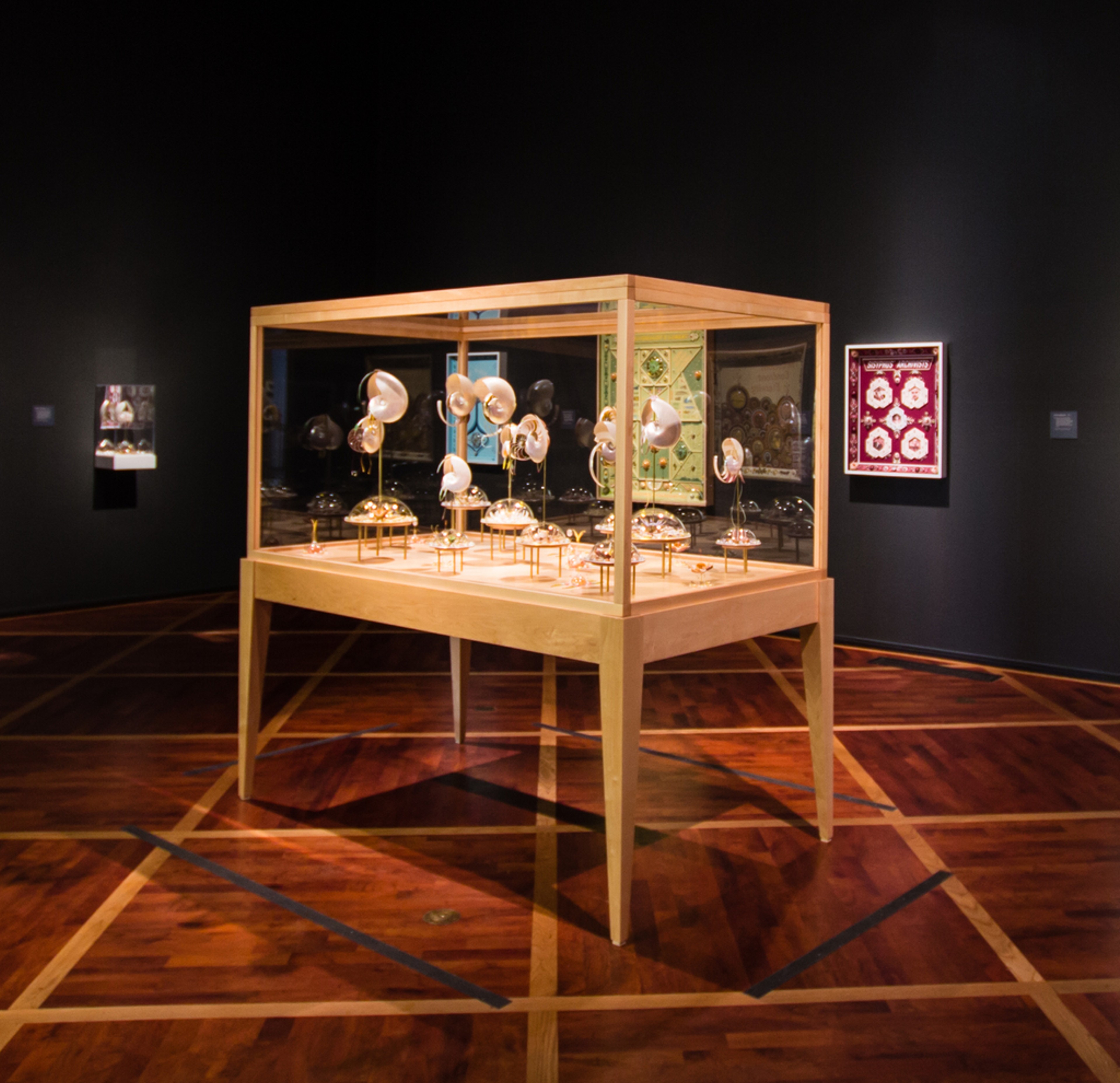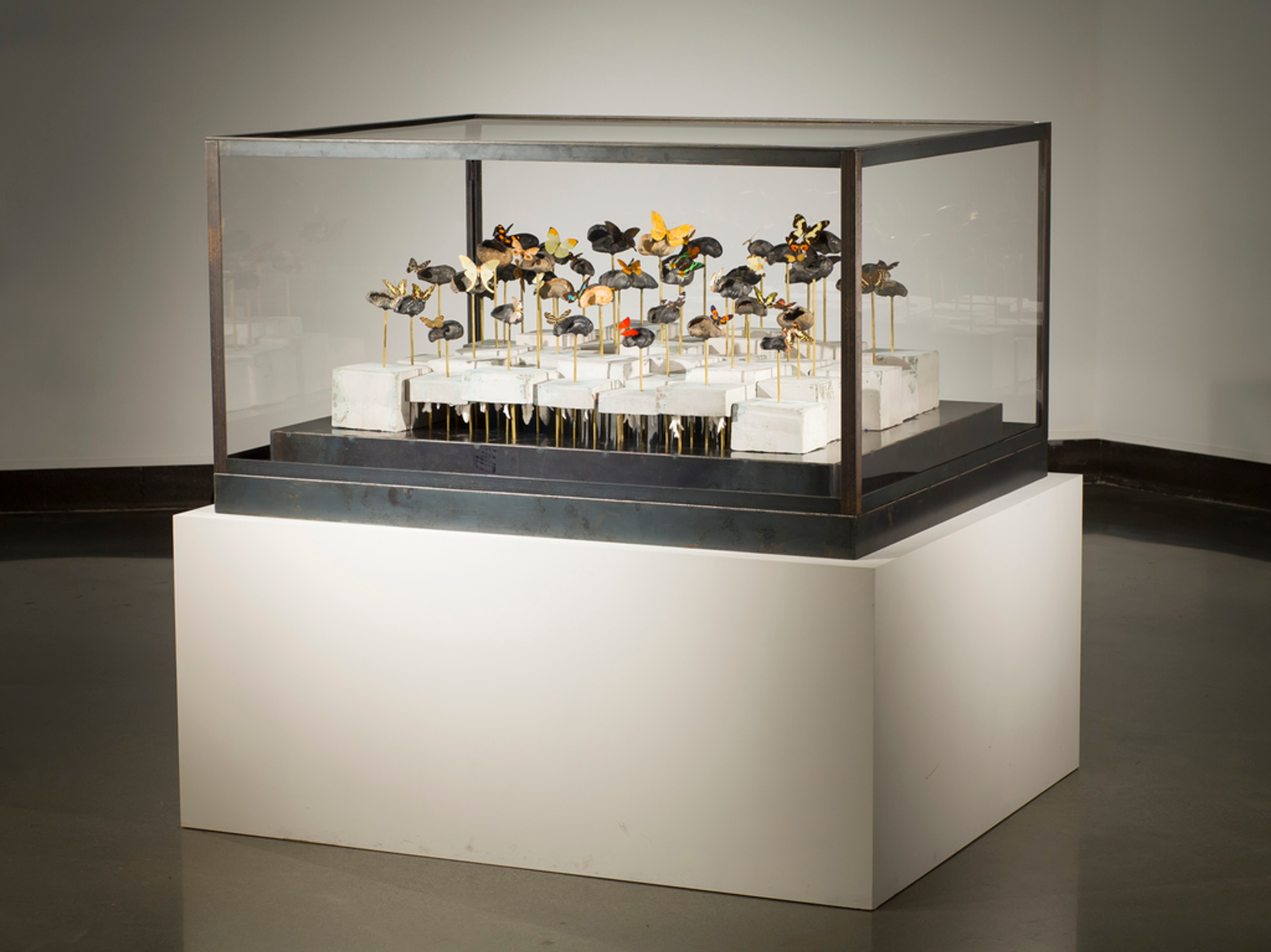Reflexive Alienation: Pondering Cosmic Otherness with Dario Robleto
We shall assume that long ago [alien Others] established a channel of communication that would one day become known to us, and that they look forward patiently to the answering signals from the Sun which would make known to them that a new society has entered the community of intelligence.
Launched in 1977, NASA’s sibling spacecrafts Voyager 1 and Voyager 2 are now over twelve billion miles from their point of origin, the watery planet known as Earth. From the cameras and other recording instruments installed on the hulls of these spacecrafts, astronomers saw their solar system as never before. They detected active volcanoes on Jupiter’s moon Io in 1979 and the cantaloupe- like texture of Neptune’s moon Triton in 1986. As the spacecrafts continue to ping their locations back to Earth today, they ferry messages from Earth ever farther into the abyss: two copies of the Voyager Golden Record a phonograph disc that, like a high- tech time capsule, transmits cultural images and sounds from the only known site of life in the universe. Long after the Voyagers’ radio transmissions fade to whimpers, these Golden Records will continue to drift as physical artifacts from Earth and its denizens, facilitating a slim-but-not- unimaginable possibility that alien Others might intercept a cosmic message in a bottle.
The Golden Record project complemented the ongoing search for extraterrestrial intelligence(SETI).1 Since the 1960s, scientists have scanned light waves within the radio and optical components of the electromagnetic spectrum for traces of alien technology. Today, astronomers train machine-learning programs to trawl data patterns believed to express universal characteristics of math and science, such as prime numbers. The Golden Record, like the SETI project, stakes its success on the anticipation of human-alien technological commensurability, the concept that the two species would be able to recognize and decode each other’s artifacts. The well-known astronomer Carl Sagan, who helped curate the record’s contents, surmised such cosmic overlap, noting, “The spacecraft will be encountered and the record played only if there are advanced spacefaring civilizations in interstellar space.”2 But could alien “eyes” and “ears” interpret the human communiqués encoded on the record? How would aliens translate the smack of a mother’s kiss and her baby’s cry? Human footsteps, laughter, and brainwaves?3 Could such sounds stir an emotional connection between species?
Robleto’s sculptures imagine the profound possibility that humans and nonhuman Others might share not only technological but also sensorial capacities and emotional registers across time and space.

It is these questions of interspecies intelligibility that the artist Dario Robleto poses to life-forms on and beyond Earth. Robleto’s sculptures imagine the profound possibility that humans and nonhuman Others might share not only technological but also sensorial capacities and emotional registers across time and space. His mixed-media curio cabinet Small Crafts on Sisyphean Seas reaches across the maw of outer space, its wondrous contents intended as gifts to alien Others. Similarly, American Seabed meditates on the temporal disjunctures between humans and animal Others on Earth. Like the Golden Record, Robleto’s gifts to life in the cosmos materially embed the prospect that nonhuman Others might be comforted by the knowledge that humans are trying to communicate beyond our species. Unlike SETI science, however, he seeks connection with alien beings through the expectation of shared emotions, not merely shared technology. Robleto thus plaits what he calls SETI science’s “logic of light” with sculpture’s “logic of objects.” If the former imagines mathematical congruency between aliens and humans, then — just as artworks on Earth provoke emotional bonds between humans — the latter aims to catalyze affective responses between terrestrial species and their planetary neighbors. Robleto asks, “Are empathy, altruism, and love also universal features of intelligent life?”4
Considered together, SETI scientists and Robleto offer touchstones for examining an epistemic mode I call reflexive alienation.5 Each party creates knowledge about life through a perpetual turning back toward the human subject (hence: reflexivity), peering upon themselves through projections of how extraterrestrial Others might perceive us on Earth (the alienation). In other words, this concept, reflexive alienation, identifies the scientific and artistic practice of imagining Others imagining us — of navel-gazing by stargazing. Humans’ self- perception deepens as a consequence of building experiments that amplify the chance for Others to discover humans. SETI scientists and Robleto reach toward nonhuman Others who may never know us, and whose messages we may never receive. Yet, it is the very act of reaching into the void that privileges an assumed, mutual desire to ease cosmic melancholy. Robleto’s work creates the possibility for humans not merely to ask ourselves, “Are we alone?” but also to ask imagined Others, “Are you also alone?”

Small Crafts on Sisyphean Seas expresses alienation, taking an extraterrestrial perspective to imagine how aliens might perceive Robleto’s Earthly gifts. American Seabed returns that perspective to Earth, reflexively dwelling in the sorrow of the seemingly insuperable material, sensorial, and temporal ruptures that exist even between terrestrial creatures. These are gifts to us humans to remind us of our desire to communicate with beings beyond ourselves, even if they ultimately spark feelings and conversations among us. Both operations, outward toward aliens and inward toward ourselves, mirror the duality of the Voyager Golden Record and SETI projects. Reflexive alienation describes SETI’s scientific, and Robleto’s artistic, practices of imagining Others imagining us. As gifts oriented toward nonhuman Others, Robleto’s sculptures, freighted with exquisite tenderness, reveal the value of materiality and the circulation of goods to interplanetary science. This earthbound art aids in understanding, and perhaps transcending, our cosmic isolation.
Reflexive Alienation: Pondering Cosmic Otherness with Dario Robleto was originally published in Michael Metzger, ed, The Heart’s Knowledge: Science and Empathy in the Art of Dario Robleto. Evanston, IL: The Block Museum of Art with the McCormick School of Engineering, 2023. Published in conjunction with the exhibition The Heart’s Knowledge: Science and Empathy in the Art of Dario Robleto at The Block Museum of Art, Northwestern University (January 27 – July 9, 2023).
Notes:
Epigraph: Giuseppe Cocconi and Philip Morrison, “Searching for Interstellar Communications,” Nature 184 (1959): 844.
1. The field of SETI emerged in 1960, when the radio astronomer Frank Drake tuned into the stars Tau Ceti and Epsilon Eridani from a radio telescope in West Virginia but heard only static.
2. NASA/JPL, “Golden Record,” accessed January 17, 2022, http://voyager.jpl.nasa.gov/golden-record/whats- on- the- record/ (emphasis mine).
3. NASA, “Sounds of Earth,” accessed January 17, 2022, http://voyager.jpl.nasa.gov/golden- record/whats-on-the-record/sounds/.
4. Dario Robleto, in conversation with the author.
5. I coin and explore this concept in depth from the perspective of SETI astronomers in my dissertation. See Claire Isabel Webb, “Technologies of Perception: Searches for Life and Intelligence beyond Earth” (PhD diss., Massachusetts Institute of Technology, 2020).
Reflexive Alienation: Pondering Cosmic Otherness with Dario Robleto was originally published in Michael Metzger, ed, The Heart’s Knowledge: Science and Empathy in the Art of Dario Robleto. Evanston, IL: The Block Museum of Art with the McCormick School of Engineering, 2023. Published in conjunction with the exhibition The Heart’s Knowledge: Science and Empathy in the Art of Dario Robleto at The Block Museum of Art, Northwestern University (January 27 – July 9, 2023).